SEO
What The Report Can Tell You

The Google Search Console Insights email that drops into your inbox each month can be a powerful tool for understanding your website’s performance and informing your SEO strategy.
While some people may just take a quick glance at the numbers and move on, your Search Console Insights reports can provide vital insights into how users are interacting with your site and reveal data to help you optimize your website strategy.
Let’s take a look at what Google Search Console Insights is and how these reports can help you.
What Is Google Search Console Insights?
Google Search Console Insights is a feature within Google Search Console (GSC) that presents an easy-to-understand group of reports to help you understand site performance.
It pulls data from GSC and Google Analytics into one place to compile the reports.
Search Console Insights offers five distinct performance views. Each gives a general overview, while also enabling users to drill down to top-performing pages and gain insights into specific search queries.
The Insights reports offer a remarkable amount of easily understood and actionable information in the form of straightforward snapshots of website search performance – ensuring that every website stakeholder can review and understand how well their content is performing.
How To Find The Search Console Insights Report
The link to Search Console Insights is not in the left-hand navigation where one might expect to see it.
The Insights reports can be accessed from the search console Overview page, in a link at the very top of the page.

Clicking through to the Search Console Insights page shows a page that looks like this:
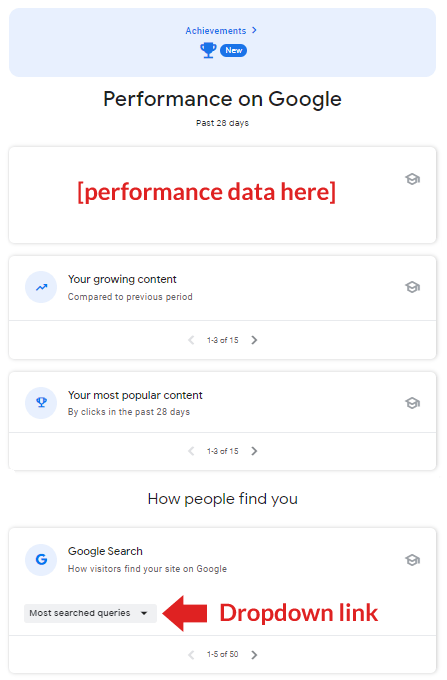 Screenshot from Google Search Console, October 2023
Screenshot from Google Search Console, October 2023
The Search Insights homepage shows the following reports:
- A link to the Achievements report.
- Performance on Google.
- Your Growing Content.
- Your Most Popular Content.
- How People Find You.
Insights Achievements Report
The top of the page contains a somewhat hidden link to the Achievements report. It’s easy to overlook.
The image of a trophy with the word Achievements is actually a link to the Achievements report.
Screenshot Of The Link To The Achievements Report
 Screenshot from Google Search Console, October 2023
Screenshot from Google Search Console, October 2023
Clicking the link takes the user to the Achievements page, which lists milestones for the site.
There is also a link to a Search Console report containing more details.
Screenshot Of Achievements Report
 Screenshot from Google Search Console, October 2023
Screenshot from Google Search Console, October 2023
The Achievement report shows data for the past 28 days against the background of data from the entire time data has been collected, archived as far back as 2019.
There are two reports in the Achievements section.
Achievements Report #1
The first report is an “in progress” Achievement report measured in clicks.
The In Progress report displays the number of clicks the site is currently attracting. A trend arrow shows whether the clicks are trending upwards or downwards.
For content trending downward, there is a link to a search console report showing which pages are trending downward.
Screenshot Of Link To Search Console
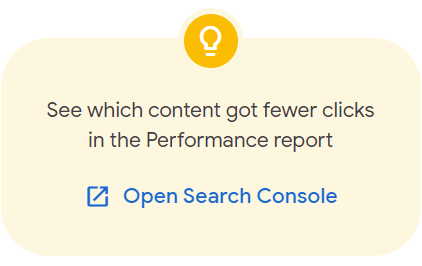 Screenshot from Google Search Console, October 2023
Screenshot from Google Search Console, October 2023
The In Progress report is useful for starting an investigation of why certain pages and search queries are underperforming compared to the previous 28-day period.
The Search Console report displays the underperforming webpages, number of clicks, clicks for the previous period, and the difference in clicks between the two periods in the comparison.
Achievements Report #2
The second report is called the Google Search Impact report.
This report shows the total number of clicks the site has attracted.
Performance On Google Report
Clicking back to the main Insights overview page, we see the Performance on Google report next.
The report is a graph that shows the daily fluctuations of site traffic in terms of clicks from Google.
The report shows the number of clicks for the past 28 days and an arrow pointing up or down, which indicates whether the clicks are trending up or down.
Your Growing Content Report
This report consists of a list of URLs corresponding to webpages receiving more traffic this period than the previous one.
The report lists the following information:
- A list of 15 URLs of pages that are trending upward.
- Number of clicks gained in comparison to the previous 28-day period.
- A percentage that represents the percentage of increase from the previous period.
- Top search queries associated with the webpage popularity growth.
The information provided in the Your Growing Content report can be used to identify whether a cyclical trend is driving the increase, an algorithmic change has improved rankings, marketing efforts have been successful, or content updates have provided positive validation.
Your Most Popular Content Report
The Most Popular Content report shows the 15 most popular pages from the entire website.
The data shown includes:
- A list of 15 URLs of the most popular webpages.
- A list of top search queries associated with each URL.
- Total number of clicks to each popular webpage.
The Most Popular Content report is useful for understanding what topics the site is authoritative for.
If the homepage is one of the most popular pages, this could be a good or not-so-good thing.
The list of search queries in this report that are associated with the homepage is meaningful.
For example, it’s good if the top search queries are variations of the brand name because that’s a signal of popularity, that people love the site so much they’re searching for it by name.
However, if the top queries are non-brand keywords, then this could be a sign that maybe the inner pages need work to get them ranking for more topics.
A site with the majority of non-brand keyword traffic to the homepage isn’t necessarily doing poorly, particularly if the site is a local business.
How People Find You Report
This report shows data about the top search queries used to drive traffic to the website.
The report shows the most searched queries and the upward-trending search queries.
The data is accessible through a dropdown menu marked like this:
- Most searched queries (past 28 days).
- Most trending queries (past 28 days).
Screenshot Of Dropdown Menu
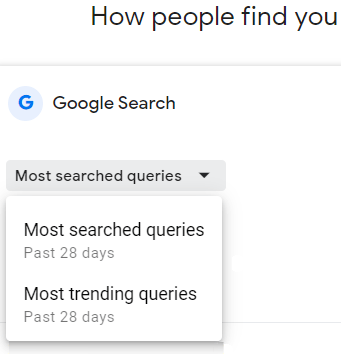

The Most Searched Queries section displays the following data:
- Search query – The query used to find the site.
- Clicks – Total number of clicks by users.
- Avg. position – Average position in the search engine results pages (SERPs) for the query.
- Top search queries – Queries that got the most clicks.
The Trending Search Queries section shows which queries are trending upwards, measured by clicks.
As with everything else, the data is a comparison to the previous 28 days.
Tip For Understanding The Reports
Search Insights contains hidden tips explaining the data you’re looking for and how to use it.
But the links are hidden behind a school graduation cap icon that is located in the top right-hand corner of each report.
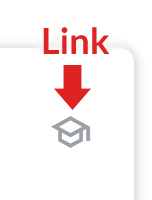 Screenshot from Google Search Console, October 2023
Screenshot from Google Search Console, October 2023
Below is a screenshot of one of the informational popups:
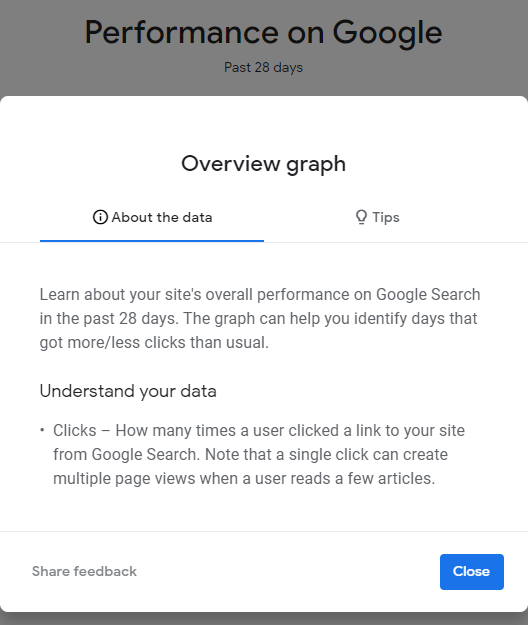 Screenshot from Google Search Console, October 2023
Screenshot from Google Search Console, October 2023
What Can You Learn From Search Console Insights?
Search Console Insights is a helpful tool for anyone who wants to master their website’s search performance.
Whether you’re an SEO consultant conducting a site audit or a site owner looking for a performance snapshot, these reports shed light on your overall site health and trends in performance.
By highlighting important metrics and insights, Google Search Console Insights enables stakeholders – regardless of their SEO knowledge – to understand the trajectory of their website and make more informed decisions about their SEO strategy.
While the report is still in beta and not yet a final product, what is currently offered is valuable for all stakeholders who want to understand their website better and boost its performance in search.
More resources:
Featured image by Shutterstock/Luis Molinero
SEO
Google Cautions On Blocking GoogleOther Bot

Google’s Gary Illyes answered a question about the non-search features that the GoogleOther crawler supports, then added a caution about the consequences of blocking GoogleOther.
What Is GoogleOther?
GoogleOther is a generic crawler created by Google for the various purposes that fall outside of those of bots that specialize for Search, Ads, Video, Images, News, Desktop and Mobile. It can be used by internal teams at Google for research and development in relation to various products.
The official description of GoogleOther is:
“GoogleOther is the generic crawler that may be used by various product teams for fetching publicly accessible content from sites. For example, it may be used for one-off crawls for internal research and development.”
Something that may be surprising is that there are actually three kinds of GoogleOther crawlers.
Three Kinds Of GoogleOther Crawlers
- GoogleOther
Generic crawler for public URLs - GoogleOther-Image
Optimized to crawl public image URLs - GoogleOther-Video
Optimized to crawl public video URLs
All three GoogleOther crawlers can be used for research and development purposes. That’s just one purpose that Google publicly acknowledges that all three versions of GoogleOther could be used for.
What Non-Search Features Does GoogleOther Support?
Google doesn’t say what specific non-search features GoogleOther supports, probably because it doesn’t really “support” a specific feature. It exists for research and development crawling which could be in support of a new product or an improvement in a current product, it’s a highly open and generic purpose.
This is the question asked that Gary narrated:
“What non-search features does GoogleOther crawling support?”
Gary Illyes answered:
“This is a very topical question, and I think it is a very good question. Besides what’s in the public I don’t have more to share.
GoogleOther is the generic crawler that may be used by various product teams for fetching publicly accessible content from sites. For example, it may be used for one-off crawls for internal research and development.
Historically Googlebot was used for this, but that kind of makes things murky and less transparent, so we launched GoogleOther so you have better controls over what your site is crawled for.
That said GoogleOther is not tied to a single product, so opting out of GoogleOther crawling might affect a wide range of things across the Google universe; alas, not Search, search is only Googlebot.”
It Might Affect A Wide Range Of Things
Gary is clear that blocking GoogleOther wouldn’t have an affect on Google Search because Googlebot is the crawler used for indexing content. So if blocking any of the three versions of GoogleOther is something a site owner wants to do, then it should be okay to do that without a negative effect on search rankings.
But Gary also cautioned about the outcome that blocking GoogleOther, saying that it would have an effect on other products and services across Google. He didn’t state which other products it could affect nor did he elaborate on the pros or cons of blocking GoogleOther.
Pros And Cons Of Blocking GoogleOther
Whether or not to block GoogleOther doesn’t necessarily have a straightforward answer. There are several considerations to whether doing that makes sense.
Pros
Inclusion in research for a future Google product that’s related to search (maps, shopping, images, a new feature in search) could be useful. It might be helpful to have a site included in that kind of research because it might be used for testing something good for a site and be one of the few sites chosen to test a feature that could increase earnings for a site.
Another consideration is that blocking GoogleOther to save on server resources is not necessarily a valid reason because GoogleOther doesn’t seem to crawl so often that it makes a noticeable impact.
If blocking Google from using site content for AI is a concern then blocking GoogleOther will have no impact on that at all. GoogleOther has nothing to do with crawling for Google Gemini apps or Vertex AI, including any future products that will be used for training associated language models. The bot for that specific use case is Google-Extended.
Cons
On the other hand it might not be helpful to allow GoogleOther if it’s being used to test something related to fighting spam and there’s something the site has to hide.
It’s possible that a site owner might not want to participate if GoogleOther comes crawling for market research or for training machine learning models (for internal purposes) that are unrelated to public-facing products like Gemini and Vertex.
Allowing GoogleOther to crawl a site for unknown purposes is like giving Google a blank check to use your site data in any way they see fit outside of training public-facing LLMs or purposes related to named bots like GoogleBot.
Takeaway
Should you block GoogleOther? It’s a coin toss. There are possible potential benefits but in general there isn’t enough information to make an informed decision.
Listen to the Google SEO Office Hours podcast at the 1:30 minute mark:
Featured Image by Shutterstock/Cast Of Thousands
SEO
AI Search Boosts User Satisfaction

A new study finds that despite concerns about AI in online services, users are more satisfied with search engines and social media platforms than before.
The American Customer Satisfaction Index (ACSI) conducted its annual survey of search and social media users, finding that satisfaction has either held steady or improved.
This comes at a time when major tech companies are heavily investing in AI to enhance their services.
Search Engine Satisfaction Holds Strong
Google, Bing, and other search engines have rapidly integrated AI features into their platforms over the past year. While critics have raised concerns about potential negative impacts, the ACSI study suggests users are responding positively.
Google maintains its position as the most satisfying search engine with an ACSI score of 81, up 1% from last year. Users particularly appreciate its AI-powered features.
Interestingly, Bing and Yahoo! have seen notable improvements in user satisfaction, notching 3% gains to reach scores of 77 and 76, respectively. These are their highest ACSI scores in over a decade, likely due to their AI enhancements launched in 2023.
The study hints at the potential of new AI-enabled search functionality to drive further improvements in the customer experience. Bing has seen its market share improve by small but notable margins, rising from 6.35% in the first quarter of 2023 to 7.87% in Q1 2024.
Customer Experience Improvements
The ACSI study shows improvements across nearly all benchmarks of the customer experience for search engines. Notable areas of improvement include:
- Ease of navigation
- Ease of using the site on different devices
- Loading speed performance and reliability
- Variety of services and information
- Freshness of content
These improvements suggest that AI enhancements positively impact various aspects of the search experience.
Social Media Sees Modest Gains
For the third year in a row, user satisfaction with social media platforms is on the rise, increasing 1% to an ACSI score of 74.
TikTok has emerged as the new industry leader among major sites, edging past YouTube with a score of 78. This underscores the platform’s effective use of AI-driven content recommendations.
Meta’s Facebook and Instagram have also seen significant improvements in user satisfaction, showing 3-point gains. While Facebook remains near the bottom of the industry at 69, Instagram’s score of 76 puts it within striking distance of the leaders.
Challenges Remain
Despite improvements, the study highlights ongoing privacy and advertising challenges for search engines and social media platforms. Privacy ratings for search engines remain relatively low but steady at 79, while social media platforms score even lower at 73.
Advertising experiences emerge as a key differentiator between higher- and lower-satisfaction brands, particularly in social media. New ACSI benchmarks reveal user concerns about advertising content’s trustworthiness and personal relevance.
Why This Matters For SEO Professionals
This study provides an independent perspective on how users are responding to the AI push in online services. For SEO professionals, these findings suggest that:
- AI-enhanced search features resonate with users, potentially changing search behavior and expectations.
- The improving satisfaction with alternative search engines like Bing may lead to a more diverse search landscape.
- The continued importance of factors like content freshness and site performance in user satisfaction aligns with long-standing SEO best practices.
As AI becomes more integrated into our online experiences, SEO strategies may need to adapt to changing user preferences.
Featured Image: kate3155/Shutterstock
SEO
Google To Upgrade All Retailers To New Merchant Center By September

Google has announced plans to transition all retailers to its updated Merchant Center platform by September.
This move will affect e-commerce businesses globally and comes ahead of the holiday shopping season.
The Merchant Center is a tool for online retailers to manage how their products appear across Google’s shopping services.
Key Changes & Features
The new Merchant Center includes several significant updates.
Product Studio
An AI-powered tool for content creation. Google reports that 80% of current users view it as improving efficiency.
This feature allows retailers to generate tailored product assets, animate still images, and modify existing product images to match brand aesthetics.
It also simplifies tasks like background removal and image resolution enhancement.
Centralized Analytics
A new tab consolidating various business insights, including pricing data and competitive analysis tools.
Retailers can access pricing recommendations, competitive visibility reports, and retail-specific search trends, enabling them to make data-driven decisions and capitalize on popular product categories.
Redesigned Navigation
Google claims the new interface is more intuitive and cites increased setup success rates for new merchants.
The platform now offers simplified website verification processes and can pre-populate product information during setup.
Initial User Response
According to Google, early adopters have shown increased engagement with the platform.
The company reports a 25% increase in omnichannel merchants adding product offers in the new system. However, these figures have yet to be independently verified.
Jeff Harrell, Google’s Senior Director of Merchant Shopping, states in an announcement:
“We’ve seen a significant increase in retention and engagement among existing online merchants who have moved to the new Merchant Center.”
Potential Challenges and Support
While Google emphasizes the upgrade’s benefits, some retailers, particularly those comfortable with the current version, may face challenges adapting to the new system.
The upgrade’s mandatory nature could raise concerns among users who prefer the existing interface or have integrated workflows based on the current system.
To address these concerns, Google has stated that it will provide resources and support to help with the transition. This includes tutorial videos, detailed documentation, and access to customer support teams for troubleshooting.
Industry Context
This update comes as e-commerce platforms evolve, with major players like Amazon and Shopify enhancing their seller tools. Google’s move is part of broader efforts to maintain competitiveness in the e-commerce services sector.
The upgrade could impact consumers by improving product listings and providing more accurate information across Google’s shopping services.
For the e-commerce industry as a whole, it signals a continued push towards AI-driven tools and data-centric decision-making.
Transition Timeline
Google states that retailers will be automatically upgraded by September if they still need to transition.
The company advises users to familiarize themselves with the new features before the busy holiday shopping period.
Featured Image: BestForBest/Shutterstock
-

 SEARCHENGINES5 days ago
SEARCHENGINES5 days agoBillions Of Google goo.gl URLs To 404 In The Future
-
SEARCHENGINES4 days ago
Daily Search Forum Recap: July 22, 2024
-

 SEARCHENGINES7 days ago
SEARCHENGINES7 days agoGoogle Core Update Coming, Ranking Volatility, Bye Search Notes, AI Overviews, Ads & More
-

 SEO5 days ago
SEO5 days ago11 Copyscape Alternatives To Check Plagiarism
-

 SEO6 days ago
SEO6 days agoGoogle Warns Of Last Chance To Export Notes Search Data
-
SEARCHENGINES3 days ago
Daily Search Forum Recap: July 23, 2024
-

 AFFILIATE MARKETING6 days ago
AFFILIATE MARKETING6 days agoThe Top 5 AI Tools That Can Revolutionize Your Workflow and Boost Productivity
-

 SEO4 days ago
SEO4 days agoSystem Builders – How AI Changes The Work Of SEO















